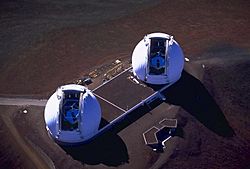W. M. Keck Observatory facts for kids
Quick facts for kids W. M. Keck Observatory |
|

The summit of Mauna Kea is considered one of the most important astronomical viewing sites in the world. The twin Keck telescopes are the two largest optical/near-infrared instruments there.
|
|
| Wavelength | Optical, near infrared |
|---|---|
| Built | Keck I 1993, Keck II 1996 |
| Telescope style | Reflector |
| Diameter | 10m each |
| Angular resolution | 0.04 to 0.4 arcseconds for individual telescopes, depending on target and instruments used |
| Focal length | 17.5 m (f/1.75) |
| Mounting | Alt/az |
| Dome | Spherical |
| Website | http://www.keckobservatory.org/ |
The W. M. Keck Observatory is a special place in Hawaii. It has two very large telescopes. These telescopes are on top of a tall mountain called Mauna Kea. This mountain is more than two miles (about 3.2 kilometers) above sea level.
These powerful telescopes help scientists study light from far-away stars. They can see things in great detail. Each telescope has a huge main mirror. These mirrors are 10 meters (33 feet) wide. This makes them some of the biggest mirrors in the world.
Even though other telescopes might have slightly larger mirrors, the Keck telescopes are designed very well. They collect a lot of light. This design helps them be the largest steerable optical/infrared telescopes on Earth. "Steerable" means they can move and point to different parts of the sky.
Contents
About the Keck Telescopes
The Keck Observatory has two main telescopes. They are called Keck I and Keck II. Keck I was finished in 1993. Keck II was finished in 1996. Both telescopes work together to give scientists even better views of space.
Why Mauna Kea is Special
Mauna Kea is a great spot for telescopes. It is very high up, so the air is clear. There are also not many city lights nearby. This means the sky is very dark. These conditions are perfect for looking at distant stars and galaxies.
How They Work
The Keck telescopes are reflector telescopes. This means they use mirrors to collect light. The huge main mirror gathers light from space. Then, it sends this light to smaller mirrors and special tools. These tools help scientists learn about stars, planets, and other objects. They can study how old things are or what they are made of.
Related pages
Images for kids
See also
 In Spanish: Observatorio W. M. Keck para niños
In Spanish: Observatorio W. M. Keck para niños


